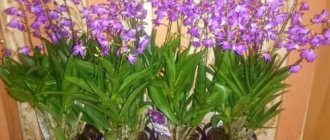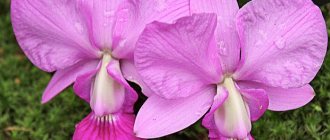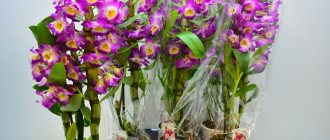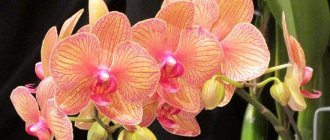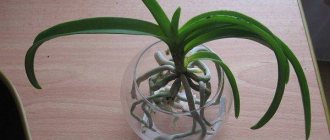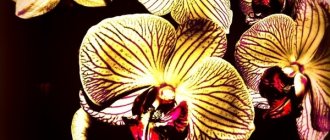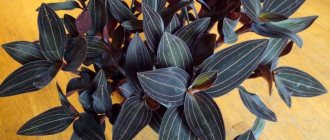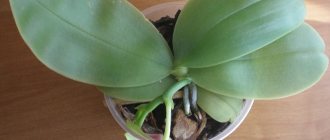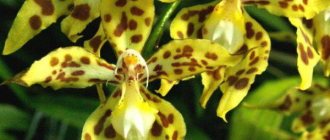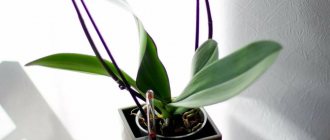Terrariums are chic glass containers that house tiny plant worlds. More and more orchid lovers are moving from growing plants on windowsills to more enclosed spaces where they can have much better control over conditions such as humidity. One of the benefits of creating a terrarium is that you can create a self-contained miniature environment quite easily. It is important to understand what will and will not work for orchids in such an environment. The main thing is to reproduce the growing conditions for the orchids that we place in the chamber. Thus, high humidity, good air circulation and adequate lighting are required.
Preparing the terrarium
- For mini terrariums, large vases or medical jars are often used. But if you are using an old aquarium, you will have to do a little work. If it was a fresh water tank, you will just need to thoroughly clean it with mild dish soap and rinse thoroughly. If it was a salt water tank, you will need to repeat this a few times and perhaps let it sit with clean water for a few days between cleanings. The reason is that any residual salt will definitely cause you grief in the future. Therefore, it is better to deal with this right away.
Decor of a dry aquarium-orchidarium and an orchidarium with a pond
For a dry orchidarium, one floor is enough, and for an orchidarium-aquarium, at least two.
The latter option is equipped with a reinforced partition, as well as a reinforced bottom, where a water filtration system is built in.
An option is possible when the sealed partition is located not horizontally, but vertically: in this case, the unusual accessory takes the form of a mini-garden and can easily be placed on the wide sill of a PVC window.
Placing the terrarium
Choose a place where the terrarium will never be exposed to direct sunlight. Glass enhances the sun's rays, resulting in an oven rather than a terrarium. Leave at least 30cm between the tank and any window surface to mitigate temperature changes occurring outside.
If you have an area with only minimal direct sunlight, you may want to consider adding a white reflective background to compensate for the amount of light entering the tank.
It may be wise to place the thermometer in an empty tank for a couple of days before you place it in the intended location. This will prevent unpleasant surprises and eliminate the need to move the terrarium after installation.
Light and air temperature
Once you've decided on your plant choice, and before placing them in your new home, you need to find the perfect location. A closed system must receive enough light, but at the same time be protected from direct rays. Otherwise, plants may get burned , since glass retains heat well and heats up quickly.
Substrate placed on top of stones. Photo used as illustration. Source: Yandex.Images
If there is insufficient lighting, you can place fluorescent lamps directly under the terrarium cover. The main thing is not to use incandescent lamps, as they get hot.
If the terrarium is placed on a cold window, the glass may become cold and your plants will freeze. Therefore, you can leave the thermometer in the container for several days and observe the temperature fluctuations.
Companion plants
It is always more effective if you use at least a few companion plants that are not orchids to make the environment more varied and interesting to the eye. Choose plants that stay very short or grow very slowly. All candidates must be able to withstand high humidity at all times. Good choices include low ferns, ivy, peperomia, short nephtis, fibrous-rooted begonias, rheo, selaginella, short crotons, and small dracaenas. You can find many of them with variegated or white, pink or red spots. These options can provide some color when the orchids aren't blooming, but keep them to a minimum or the setting may look too busy and less natural.
In addition to filler plants, you can also use companion plants that are commonly found with orchids, such as members of the bromeliad family. Tillandsia and Cryptanthus are excellent choices and will also bloom producing very exotic flowers. They can even be mounted higher up on poles to create a realistic jungle look.
What is an orchidarium?
Orchidariums are conventionally called any type of flower display or closed terrarium in which orchids are grown. Essentially, this is just a separate “house” for orchids. This can be a huge room with climate control or a small decorative vase with installed lighting and classified as a florarium. Unlike orchidariums in botanical gardens, home ones are distinguished not only by their compact size, but also by their great variety.
Epiphytic orchids are grown in orchidariums. They are not necessarily placed on blocks, but this method is preferable even for those species that can grow in the substrate.
Orchidariums provide a unique opportunity to create an environment with high humidity to reveal all the beauty and characteristics of plants. This is an ideal home for deciduous, capricious orchid species that require stable humidity, which under normal conditions may be depressed.
Not only orchids are grown in orchidariums: the latter in the collection can be combined with other capricious exotic epiphytes, including various moisture-loving bromeliads. Where moisture accumulates, at the bottom of orchidariums, other plants can be planted directly into the soil, creating an excellent background for orchids - peperomia, ferns, and other stars of wet terrariums.
Orchidariums are divided into two types:
- Purchased or ready-made models of varying complexity and functionality.
- Handicraft or homemade orchidariums.
The orchidarium is both a huge room with climate control and a small florarium. © glavchudo
Filling the terrarium
Rinse the pebbles in water to remove dust and debris. Place a layer of stones at the bottom. Add sphagnum moss. Leave the center lower as the orchid will nest there. Sphagnum moss is quite fluffy, try to put enough of it in so that the orchid has a strong layer in which to grow.
Leaving orchids in their original clear pot is the best way to ensure proper growth and the least amount of damage to your colorful and beautiful plants. Once the bottom stones are in place, place one or two orchids inside the terrarium. Using sphagnum moss to hide the pots will give the terrarium a finished, fantastic look. If the orchid has roots that were above the pot, carefully place them in the terrarium on top of the sphagnum moss.
DIY orchidariums
Home orchidariums are always the most economical options, but not in every case they are the most modest. They are made from available materials by those who love to tinker and experiment. It is better for those gardeners who have previously dealt with aquariums or terrariums (at least florariums with lighting) and have at least minimal experience in organizing additional lighting and a consistently moist environment for growing capricious plants to build an orchidarium on their own.
It is better for beginners to first experiment with florariums, and only then test themselves with much more valuable orchids grown in special “room houses”.
Home orchidariums are options for homemade flower displays and florariums. They can be either large, designed for a collection, or created for a single orchid.
Most often, orchidariums are created on the basis of an aquarium, choosing the size, shape, model, style to suit your taste and your interior. Both frame and glued aquariums with one removable side wall and a glass thickness of 6 to 8 mm are suitable for orchidariums.
If the aquarium model is open, then the removable wall is replaced with a “lid” made of plastic, acrylic, plexiglass (high wear resistance and transparency are important). Large glass vases of original shape can also be used to create an orchidarium, especially if you plan to place only a few miniature orchids in it.
Planning is the key to success in creating home orchidariums. Disappointment and loss of plants can be avoided if you think in advance not only about the additional elements that will be used in creating the orchidarium, but also about the entire functional component.
The type and intensity of lighting, the method of attaching sensors or systems, the laying of communications, holes or gaps for ventilation, a mesh or frame for attaching plants - all this must be “calculated” in advance. Having carefully drawn up a plan and studied the operating features of plant life support systems, you should not forget about protection from moisture, safety measures when working with electrical devices and wiring, and additional decor.
Home orchidariums have several required elements:
- Lighting system - special phytolamps, lamps for supplementary illumination of plants, or, in extreme cases, fluorescent lamps (usually standard 36 W lamps are used), which create a full spectrum of illumination for plants. Additional lighting is necessary for any orchidarium that is not located on a south window. For orchids, the lighting system is designed so that the plants receive light in an amount of about 20,000 lux for light-loving species.
- Ventilation system - holes that allow plants to breathe and provide a stable flow of fresh air or specially installed fans that provide constant air renewal (special ventilation systems for plants and ordinary computer fans are used).
- Communications - holes and channels for electrical wires and other functional elements.
- Protective elements and fasteners are special “thresholds”, supports, coverings that hold the decor and plants in place, which make the composition inside the orchidarium stable and maintain the isolation of the orchidarium itself.
- Decorative or interior elements are additional decor and accessories that will turn the orchidarium into a work of floral art.
or auto-spraying system is rarely installed in homemade orchidariums, but it simplifies maintenance as much as possible and is the most expensive element.
Caring for plants in a homemade orchidarium requires much more effort. Plants on blocks are watered and sprayed daily, in winter - every 2-3 days, but in pots - about once every 2 weeks. Orchids are planted according to standard methods, using well-adapted and quarantined plants.
When caring for plants, follow all recommendations on the characteristics of growing specific plant species. Humidity should remain within the range that is comfortable for the plant, without excessive air stagnation and dampness, but also without excessive dryness.
Regular ventilation is carried out depending on the availability of ventilation holes. Every year, all elements of the orchidarium are treated from mold, bacteria and contamination with solutions of special fungicides.
Every year, all elements of the orchidarium are treated from mold, bacteria and contamination with solutions of special fungicides. © Klairvoyant Orchids
Caring for orchids in a terrarium
Orchids are found throughout the world and grow in a wide range of climates. However, most orchids you find in stores are more tropical in origin. That's why orchids love humidity and bright, indirect light. A bathroom or adjoining room is a great choice.
Avoid exposing orchids to freezing temperatures, as most cannot handle it.
A potting mix that drains well but also retains some moisture (such as sphagnum moss is a good base).
Orchidarium interior
The internal filling of an orchidarium is usually called the interior. These are such special objects that, as a rule, they do not skimp on details in their design and create highly decorative compositions that imitate natural conditions, looking like a jungle or corners of wildlife in a window. Imitation of a tropical forest is a classic. For an orchidarium, you can imagine and experiment with style endlessly.
If orchidariums imitate the jungle, usually driftwood, branches, fragments of bark and other “blocks” that imitate the usual for epiphytic orchids are introduced into it from a number of specially processed and intended for growing epiphytic plants options - from artificial imitations to natural models that require regular replacement.
At the bottom of any orchidariums, an imitation of soil or leaf litter is placed - a base is created from expanded clay or stone chips, covered with a layer of sphagnum, which not only plays the role of a decorative background, but also creates an optimal environment for the accumulation of water and maintaining humidity. Plants are placed on stands or driftwood so that they do not touch the bottom.
Other options for arranging orchidariums may even include the absence of additional decor using special containers or flowerpots. Plants can be either planted on blocks or placed in a substrate - it all depends on what effect you want to create and what style you have chosen.
Orchidariums can be strict, with plants placed in a certain order on a “clean” background, creating the illusion of continuous landscaping, similar to an ordinary collection of plants, or imitating fragments of landscapes. In addition to additional plants, you can use accessories and decor to create an atmosphere.
Watering and humidity
It is best to use rain or distilled water for orchids, since it is impossible to get rid of accumulated salts in the terrarium. It is enough to lightly spray with plain water every 4 days. This will depend on the location and ventilation. Humid air tends to sink, so little moisture escapes unless you have fans running.
Placing 2cm of water in the rocks creates a moist environment in which the orchids can live. Make sure that orchid roots are not placed in standing water, as they may rot.
If the terrarium appears dry, simply add water to increase the humidity in the self-contained environment. If the terrarium appears consistently damp along the walls, open it briefly to remove some of the moisture.
Note. Some people prefer to use soil at the bottom of the terrarium. Despite its beautiful appearance, it is easy to introduce disease into the terrarium if soil is used as a substrate.
Industrial orchidariums
Ready-made orchidariums are chosen primarily based on price and their own preferences. Chrome or plastic, glass or transparent acrylic, full climate control or its simplest systems determine the cost of the orchidarium, as well as the opportunities it opens for growing rare species of orchids.
Conventionally, all ready-made orchidarium models are divided into regular and premium models .
Premium orchidariums
Premium orchidariums, or professional orchidariums - models that are equipped with a full-fledged climate control system that creates ideal conditions for growing orchids or those orchidariums that are created by specialized companies to order for the individual characteristics of the house and plants, mainly for the purpose of creating special interior decoration and the pride of the collection.
They are chosen if you have an unlimited budget and possibilities, or if you want to really move to a new level in collecting rarer and more valuable orchids.
Elite and professional orchidariums are characterized by a large selection of sizes, but, as a rule, even in the smallest orchidariums there are several levels of plant placement, at which the lighting intensity differs. Such models are never designed for one plant: they are a “home” for entire collections, often heterogeneous in their requirements.
Climate control systems for premium orchidariums usually include functions for controlling lighting, ventilation, watering control, air humidity, spraying, temperature, bottom heating, and sensors that allow you to check and set all the indicators necessary to create a strictly controlled atmosphere with corresponding indicators.
Plants for professional orchidariums are selected so that they are satisfied with the same temperature regime. Lighting can be changed by choosing the right location, but the temperature will be similar for all orchids placed in the orchidarium. Therefore, they are used for the collection of either heat-loving, cold-loving, or “average” orchids.
In premium models you can grow any of the indoor orchids - both the rarest and quite typical for residential premises, but capricious. On the upper levels they enjoy an ideal humid environment and intense indirect light, for example vandas, laelia and dendrobiums.
On the middle shelves (in diffused soft lighting) cattleyas or oncidiums bloom magnificently, and on the lower shelves masdevallia, paphiopedilums and phalaenopsis perfectly reveal the ability to bloom for an amazingly long time. In such orchidariums you won’t have to worry about either beautifully flowering or decorative deciduous species.
An orchidarium is the easiest option to introduce orchids even where there are no windows at all. © Orchidcare UAB
Regular purchased orchidariums
These are models without complex automatic control systems. They are effectively a terrarium or flower display with the usual rudimentary lighting and ventilation system, usually located at the top of the model. Today, more and more often, in addition to these two components, orchidariums and flower displays are equipped with a thermometer and a hygrometer, which allows you to see humidity and temperature indicators and change them accordingly by adjusting the ventilation schedule.
There is no talk of a general automatic control system, but the simplest devices simplify the task of creating ideal conditions for growing a collection of orchids. To create comfortable conditions, you need to monitor the plants and resort to small tricks.
In the simplest models, the temperature is lowered by ventilation or by installing them in rooms with low temperatures, air humidity is controlled by ventilation, opening the doors or “roof”, installing trays and water-soaked sponges and oases.
More economical options are models for small collections. In simple orchidarium models, plants are usually grown that are similar to each other not only in terms of temperature requirements, but also in terms of lighting. They cannot accommodate a scattered collection, because they do not have several levels of plant placement. There, for example, you can place oncidiums with cattleyas together, but not oncidiums with vandas and phalaenopsis.
In “multi-level” models of orchidariums you can grow any of the indoor orchids - both the rarest and quite typical for residential premises, but capricious. © fieldofscience
Transfer
You can ignore the need to repot your orchids as they will attach to other surfaces in the terrarium and will be quite happy if left alone.
Pests and possible problems
If you live outside the normal range of orchids, you probably won't have many problems with insects. Remove any visible pests immediately and, if necessary, use the lowest concentration of pesticides possible.
Orchid leaves can become sunburned if exposed to direct sunlight. It starts as dark spots on the leaves that eventually become dry and golden (and look like fall leaves).
Most orchid species are relatively forgiving, with leaves, stems and roots containing a lot of water. A forgotten orchid will last a long time before it dies. Don't rush to discard your orchid if it seems unhealthy, take the best care of it and it may recover.
Features of growing in pots in an aquarium
The peculiarity of placing orchids in flower pots in aquarium-terrariums is :
- In the correct watering;
- And ventilation.
The microclimate of the aquarium is quite favorable for them and is very close to natural. The main thing is to ensure timely air circulation inside the container, especially in the root area.
Important! Stagnant, humid air promotes the development of fungal diseases.
